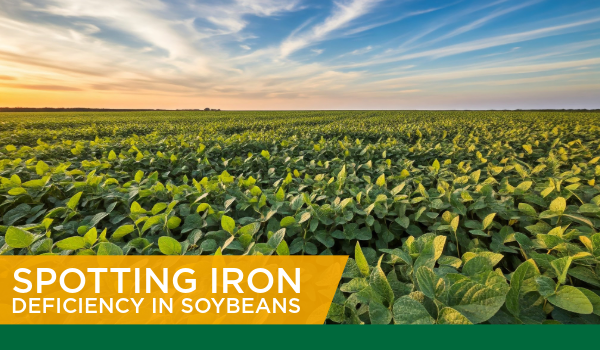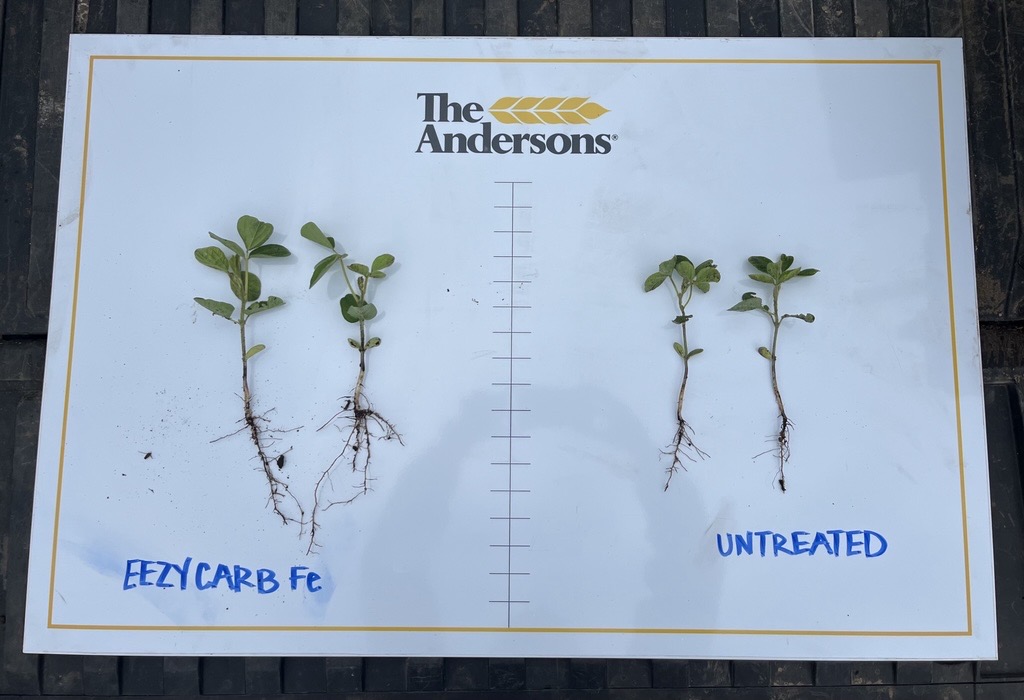Iron Deficiency Chlorosis: How to Spot and Prevent
Posted Posted Bethany Widman, Research Agronomist on July 21, 2025

As mid-season approaches, so does the potential for nutrient deficiencies. A common nutrient deficiency that growers throughout the Midwest experience is iron deficiency chlorosis (IDC), one of the top causes of yield loss in soybeans.
What is Iron Deficiency Chlorosis?
Iron Deficiency Chlorosis in soybeans occurs when the plant is unable to absorb iron from the soil. In many cases, iron levels in the soil are sufficient, but it is present in a form that plants are unable to take up. Without enough available iron, plants are unable to make enough chlorophyll, leading to the yellowing of the leaves, stunted growth, and overall lower yields in the field.
Soils with high pH, high lime levels, and high salt content make it even harder for soybeans to take up iron, especially during early growth stages. That’s why IDC is especially common in poorly drained, high-pH fields across the Midwest and northern plains.
Common Causes of IDC?
Iron deficiency chlorosis is usually caused by soil conditions that make iron unavailable to plants, rather than a lack of iron itself. It most often occurs in soils with high pH, excessive lime (calcium carbonate), and high salt levels. These conditions interfere with the roots' ability to absorb iron, even when it’s present in the soil. Poor drainage and soil compaction also contribute by restricting root growth and function, which further decreases iron availability. Additionally, early-season weather patterns, such as cool, wet soils, can cause IDC symptoms by stressing the plant during key growth stages.
Identifying IDC
The most common IDC symptom in soybeans is interveinal chlorosis, where the leaf turns yellow while the leaf veins stay green, because the plant was not able to take up a healthy amount of iron needed by the plant. Plants that suffer from IDC can also have less vigor. This means that the plant has less energy, slowing growth and reducing yields. Both of these symptoms most commonly start to show in the younger leaves of the plant.
In severe cases, the edges of the leaf may die, and if the issue persists, leaves will start to fall off, and the growing point of the plant can be damaged or die. If IDC is not managed, crops will see a yield decrease at harvest. The field can also be prone to IDC in future years if the soil conditions are corrected to make iron more available to plants.
Managing and Preventing IDC
The best way to manage IDC is by scouting fields early and often. Fields with a history of IDC or those with high-pH and high-CCE zones are at greater risk. Soil testing regularly is a great way to know a field’s pH, CCE, and salinity levels. This can help growers make more informed management decisions for their fields.
Growers can help prevent IDC in their fields by mixing in Iron 4.5% EDTA with their high orthophosphate starter fertilizer like 6-24-6. This will provide crops with iron right off the bat, reducing the chance of IDC in that field. This can be an essential tool for preventing or mitigating deficiencies in fields that have a history of IDC.
Another great way to manage IDC is by applying a foliar fertilizer that contains iron. Products like Micronourish® Fe and Eezy® Carb Fe can be applied in a foliar application, allowing growers to give crops iron in an available form right when it needs it.
Both of these products can be used as a preventative or corrective tool for IDC. In 2025 field trials, Eezy Carb Fe was applied at the 1qt/acre rate on soybeans at V5 in South Dakota.
When scouting the field, agronomists were able to see a significantly larger plant and root system compared to untreated plants. This application of Eezy Carb Fe early in the season helps the soybean crop avoid issues with IDC later on in the growing season.

Another effective tool for managing IDC is choosing IDC-tolerant soybean varieties. Some soybean genetics are better equipped to handle chlorosis stress and maintain yield potential in challenging soils. Pairing these genetics with cultural practices like improving drainage, minimizing compaction, and managing early-season nitrogen can help reduce IDC pressure.
Giving Soybeans a Boost and Preventing IDC
Giving crops the right nutrition to prevent and manage IDC is the best way that growers can ensure that they are protecting their crops. Micronourish Fe, Eezy Carb Fe, and Iron 4.5% EDTA are trusted solutions from The Andersons that can help growers combat IDC.
To learn more about these solutions or have any questions, reach out to your territory manager today.
Interested in building these products into a full-season plan? Check out our High Yield Solutions.


